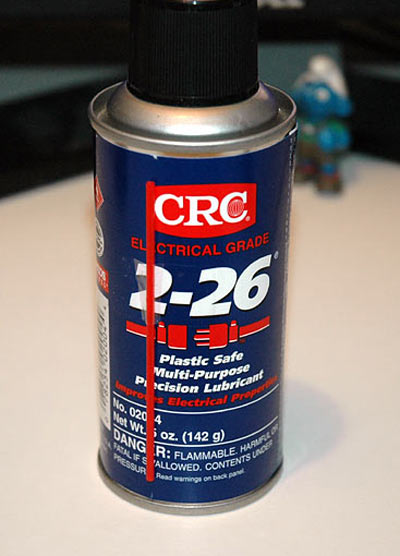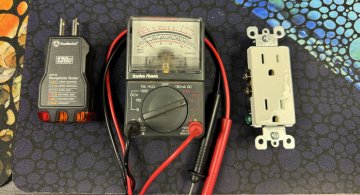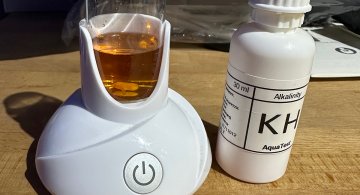How to Test for Stray Electricity
Feeling a jolt? Investigate it now
Stray electricity in the aquarium is unsafe for you as well as your livestock. Usually the only time it is noticed is when a person reaches in the tank with a nick on their finger, quickly feeling a tingle or even a jolt. After that unpleasantness has passed, it's time to determine what is causing it.
There are worse scenarios, such as that acrid smell, sparks, or even fire. Let's assume that is not the case, because if it is you should be calling 911 rather than perusing my website.
First of all, you will need a voltage meter. I prefer a digital meter over analog, because you can read the results precisely instead of watching a fluctuating needle. Such meters are available at your hardware store, Radio Shack or Harbor Freight. Wearing rubber-soled shoes during this test is important too, especially if the floor is damp or wet. Concrete floors, tile, wood, or carpeting all have the ability to conduct some electricity, and your safety comes first.
If your aquarium and/or your sump have grounding probes installed, you need to remove these prior to the test. The purpose of a grounding probe is to divert stray electricity from an object to the ground wiring of your place of residence. Once the probe has been removed, any electricity in the water will show up as a measurement on the meter.
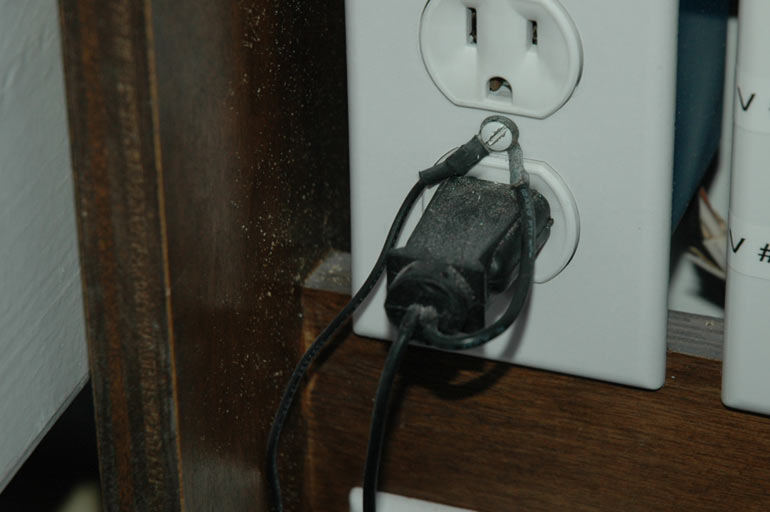
Two different grounding probes are connected both in the outlet as well as the center screw. These were removed for testing.
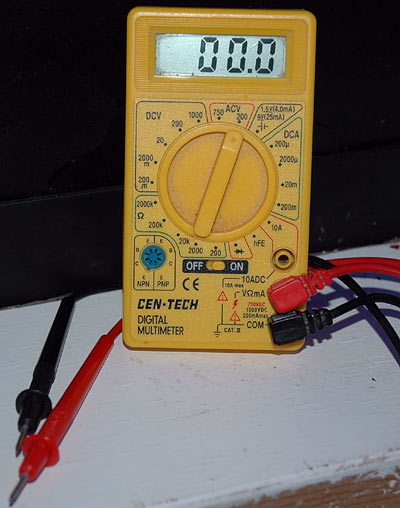
This digital voltage meter from Harbor Freight was less than $7 (on sale).
Turn the meter on, and adjust the device to measure 200v AC power. One probe is inserted into the ground hole of a nearby outlet, the other into the water. The reading you want to see is 0. Do this test in the sump as well as the aquarium. Remember that water conducts electricity, so a leaking pump in the display tank will affect the water in the sump because the water in circulation between the two is still in movement. Common sources of electricity are going to be powerheads, heaters, and lighting. If any of these are failing or aren't grounded properly, they need to be repaired or replaced.
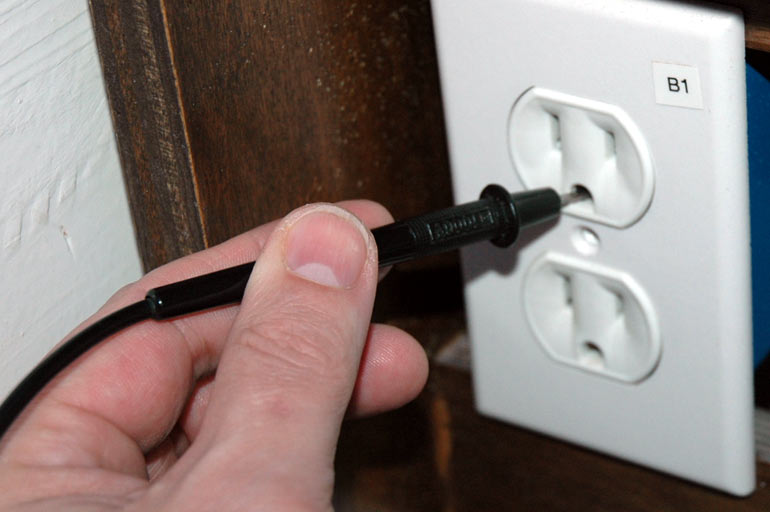
Black probe is inserted into the ground hole.
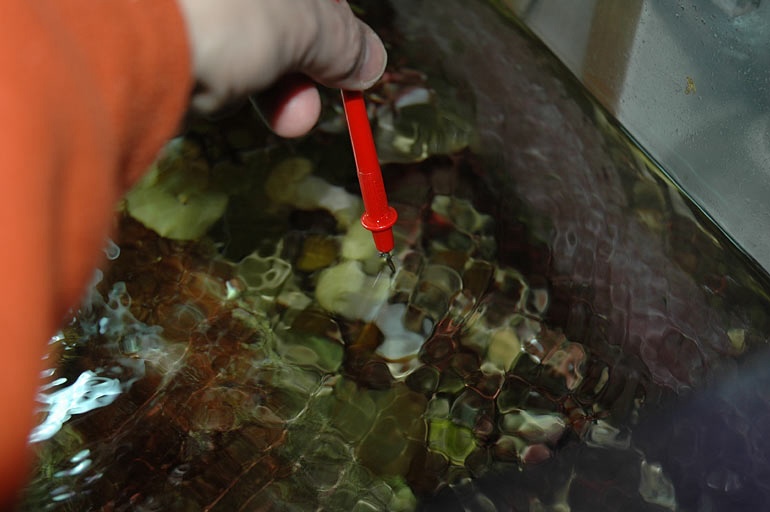
Red probe is placed in water.
If you don't have an outlet close enough to do this test, run an extension cord to where you are working. The cord should have a grounded prong though; an older cord lacking this prong won't work. Also if you are using a pump that has that prong broken off, either accidentally or intentionally, that needs to be resolved. Years ago, people would remove this prong out of annoyance because the nearby outlet didn't have room for three prongs for whatever reason. This type of risky behavior is just begging for disaster.
In speaking to one hobbyist, he told me that water had seeped under the floorboards of his home and into the house wiring beneath. He could feel the shock when simply feeding his tank, to the point that he would stand at a distance to toss the food in. Crazy, but true. Eventually he found out what was happening and had it repaired. In my own tank, I had a number of items leaking power to the combined amount of 48v. One was a still functioning powerhead in my refugium that was over 10 years old. Removing that pump dropped the reading on the meter to 16v. One by one these were all removed or replaced until the system was measuring 0 again.
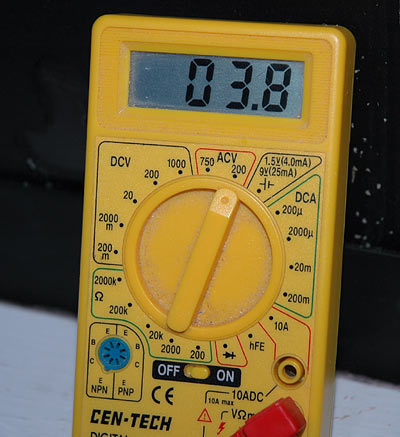
To determine what item or items are leaking power into the water, turn off every single item. That may require unplugging every cord. With the meter at the ready, plug in one item, and test with the voltage meter as directed above. If the number stays at zero, plug in the next item and retest. When the numbers suddenly jump, that's the culprit. You may discover that a number of items are individually releasing a little power into the system, but as a group it adds up. A few small powerheads leaking a little bit of power isn't a disaster yet, but should be replaced as soon as possible.
In being reasonable, isolate the items causing the problem and determine what can be fixed immediately and what may need to be fixed in a day or two. If the return pump is the cause and yet you can't get a new one until Monday morning, so be it. If it is a cracked or broken heater, it probably should be removed immediately because the metals within can do even more damage if left as is. If the reflector is the cause, screw a (green) ground wire to it and run this to the ballast's grounding screw. As soon as you know what the problem is, you can determine what priority you need to apply to the situation, but it should your top priority. The risk of you or your family getting zapped is important, but your livestock (such as Tangs that will exhibit HLLE symptoms) and corals will decline the longer it goes on. Electricity and saltwater can even arc to the point that a fire may break out causing massive losses to your home and finances. Don't delay!
Grounding probes should be reinstalled once everything has been tested, as they protect you from being shocked. Think of them as a fail-safe backup, not the cure to this problem. Any 6-way power strips that have begun to age or display signs of salt creep need to be replaced before an issue develops. These power strips are relatively cheap, but they do not last forever in salty, humid environments. Check them closely to see any signs of discoloration, cracking, or melting. If you have any doubt at all about it, replace it with a new one.
Lastly, if you have stubborn plugs that are hard to insert or extract from outlets, this product is a wonderful solution that is safe to use. Spray it on the prongs, wipe them off of any excess liquid, and plug it in a few times to lubricate and protect the outlets internal clips. This product is sold in the electrical department at Home Depot.
